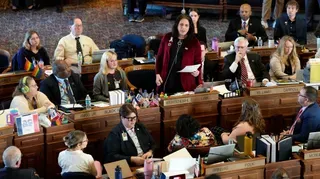November 30, 2014
SF Leaders Detail Plan to Cut HIV Infections to Zero
Kilian Melloy READ TIME: 8 MIN.
San Francisco leaders have mapped out an aggressive plan to cut new HIV infections by 90 percent come 2020.
The ultimate goal is to get to no new HIV infections, though backers of the plan have yet to commit to a target date for meeting it.
"Our hope is this is a plan that really makes San Francisco the first city in the nation, and essentially the world, to really virtually drive the epidemic out of existence," said Project Inform Executive Director Dana Van Gorder. "This is something I hope everyone will want to embrace and participant in."
For the last year a group of 25 leaders, representing the public health department, city hall, community groups, private health care providers, and UCSF officials, have been meeting regularly to devise a multi-pronged strategy to dramatically reduce new HIV infections in the city. Their work has led to the creation of a plan dubbed "Getting to Zero: Zero HIV Infections, Zero AIDS Deaths, and Zero Stigma."
Three of the key components are rapid enrollment in treatment for those who test positive for the virus; retention of people once they are in care; and ensuring those who are HIV-negative and at risk for HIV have access to pre-exposure prophylaxis. Known as PrEP, the once-a-day pill marketed by Gilead Sciences as Truvada (tenofovir plus emtricitabine) has been shown to prevent HIV transmission when taken properly.
"We can make gains as a municipality we have never been able to do before. We can be the first municipal jurisdiction to achieve our vision of getting to zero," said Dr. Diane Havlir, chief of the UCSF Division of HIV/AIDS at San Francisco General Hospital.
The implementation of the Affordable Care Act this spring, and the expansion of Medicare in California, have also bolstered health officials' belief that eliminating new HIV infections is doable as more people now have access to health care.
"I think the ACA makes it a great achievable goal," said Barbara Garcia, the city's health director. "Prior to this, trying to get people into care was sometimes hard. Not everyone was covered, so that is a major component."
Garcia stressed that buy-in to the plan cannot come from health providers and local officials alone. The community, particularly gay men who account for the majority of new HIV cases in San Francisco, needs to embrace the Getting to Zero initiative.
"The health department couldn't do this on its own," she said. "It is really a collaboration."
Van Gorder said he is confident that gay men, especially, will find the plan's elements "fairly logical" steps that can be achieved.
"I think there is evidence from a lot of sources that, between the advantages of HIV treatment for personal health and prevention, and with the advent of PrEP, we could really finally lift the cloud that has been hanging over our lives for 30 years," he said. "Both for guys like me, who have been around from the very beginning, and for young men just coming here that still find HIV plays a significant role in their lives."
HIV Rates Have Been in Decline
Since 2006 new HIV infections in San Francisco have dropped dramatically, going from 517 diagnoses 12 years ago to 359 last year, according to the 2013 HIV Epidemiology Annual Report released this summer. The latest data was welcome news to HIV officials, who earlier this year expressed concern at seeing a slight uptick in new HIV infections between 2011 and 2012.
The number of deaths attributed to HIV has also been dropping precipitously. There were 327 in 2006, and by 2013, the number had fallen to 182. The city estimates there were 15,901 people living with HIV in San Francisco last year.
In 2010, when new HIV infections totaled 434, the city health department had set a target of cutting new HIV infections by 50 percent by 2015 as one of the goals of the San Francisco HIV Prevention Plan. Because it took several years to implement programs called for in the plan, the health department pushed back achieving its goal of cutting new HIV infections in half to 2017.
Tracey Packer, the health department's director of community health equity and promotion who oversees the city's HIV prevention efforts, told the Bay Area Reporter in a recent interview that getting down to 217 new HIV cases in three years is achievable.
"The number of new infections, or newly diagnosed infections, is trending downward," said Packer. "I think we would expect the numbers to continue to go down."
At the same time the health department has significantly ramped up the number of HIV tests that are performed per year. It also began encouraging sexually active gay and bisexual men to get tested every three to six months, as opposed to yearly, and recommending those who do test positive to start treatment immediately.
Not only would doing so benefit their own health, but by ensuring their viral loads were suppressed, they would be less likely to transmit HIV to their sexual partners.
It was part of a new model, dubbed "test and treat," that the city's former HIV prevention director, Grant Colfax, pushed through three years ago amid strong reservations from nonprofit HIV service providers.
Testing has since increased from 17,000 annually to roughly 27,000, said Packer, falling just shy of a target of hitting 30,000 HIV tests per year by 2013.
"I think we would expect at least 27,000 in 2014, and it could be higher than that," predicted Packer.
PrEP A Key Piece of the Puzzle
Those initiatives laid the groundwork for the new Getting to Zero plan, and the growing faith in the efficacy of PrEP has culminated in the expectation that San Francisco can halt the transmission of HIV locally.
"I think we have a very strong foundation for getting to zero," said Packer. "We see newly diagnosed infections trending downwards. We see linkage to care and retention to care rates are high."
Packer added that "PrEP is an additional prevention tool in our toolbox. There are many tools we have and PrEP has added to that. I think the addition of PrEP will help us get to zero."
It is estimated that less than 1,000 city residents are currently taking PrEP. For there to be significant reductions in new HIV infections in the city, officials with UCSF's 360: The Positive Care Center have estimated at least 6,000 people should be on it.
This fall the Board of Supervisors, at the urging of gay District 9 Supervisor David Campos, allocated $301,600 to hire "navigators," or counselors, who will help people obtain PrEP through existing channels such as private insurance, Medi-Cal, or Gilead Science's patient assistance programs. The funds will not directly pay for PrEP medications.
"To me probably the most challenging part is expanding access to PrEP because of the costs, because of the number of people who have inadequate insurance, and because of the stigma that continues to be associated with PrEP," said gay District 8 Supervisor Scott Wiener, who revealed in September that he is taking Truvada. "We still have a lot of work to do around stigma and increased access to PrEP. That to me is going to be the biggest hurdle."
Yet tackling the stigma issues, whether it is doctors who refuse to prescribe PrEP to their patients or men feeling ashamed and being criticized for taking it, will be tricky to address, said Dr. Susan Buchbinder class=st>, director of Bridge HIV at the San Francisco Department of Public Health and a clinical professor of medicine, epidemiology at UCSF. Nonetheless, doing so is key to achieving an end to HIV transmission, she noted.
"We won't get to our goal unless we address the stigma issues," said Buchbinder. "Without addressing stigma we will not get to our goals with treatment and prevention."
The reason, she added, is that "stigma is a big issue that prevents people from accessing appropriate care around HIV, as well as preventing open communication between people about their HIV status and what their health is like."
There are those who question focusing so much attention and resources on the expansion of PrEP. Officials with the AIDS Healthcare Foundation have been the most vocal about raising concerns about the effectiveness of PrEP when not taken as recommended.
Others have cautioned about seeing ongoing spikes in the rates of sexually transmitted infections if people forego condoms because they are on PrEP. The medication does not prevent against STIs, and the city continues to see yearly increases in cases of gonorrhea, syphilis, and chlamydia.
During a recent presentation about the Getting to Zero plan before the city's HIV Prevention Planning Council, member Cyd Nova voiced worry about an overemphasis on PrEP as part of the strategy to cut new infections.
"I don't think this tool will work for everybody," said Nova. "I am concerned all this focus on PrEP will take away from other HIV prevention tools."
In an interview with the B.A.R. Van Gorder said that it is not incumbent upon all HIV-negative men to use PrEP in order for the city to achieve its goal.
"I don't believe PrEP is for everyone by any stretch of the imagination," he said. "There are many people who can clearly benefit from it and help us prevent further infections."
Wiener cautioned that relying on people who are HIV-negative using PrEP is not enough to achieve the goals of the Getting to Zero initiative.
"PrEP has been a major step in allowing us to envision a future without HIV. But PrEP by itself is not enough," said Wiener, who with Campos has been taking part in the consortium meetings to devise the plan. "We have to continue to ramp up our testing efforts to make sure people are getting tested regularly, that people know their HIV status, and for those people who do seroconvert that they get quickly connected to treatment so they suppress their viral load."
Buchbinder told the B.A.R. that PrEP has a key role to play in achieving the getting to zero goal. While community-embraced strategies such as serosorting, where men choose to have sex with only men of the same HIV serostatus, or seropositioning, where men determine what sexual behaviors they will engage in based on their partner's HIV status, have helped kept HIV rates low in San Francisco, they alone are not enough to stop transmission of the virus.
"I do think the PrEP piece is incredibly exciting. This is the most effective new intervention we have had for HIV, particularly in our population of men who have sex with men, really since the community developed their own strategies for driving down new infection rates," said Buchbinder. "They are a 10th or 20th of what they were at the start of the epidemic. But we have either been level or rising and not able to get down as much as we want. We haven't had these types of new interventions for negatives. It brings together the entire community so everyone can see something they can do, whether for themselves, for their partners, and with their friends, that can achieve this goal."
The Getting to Zero plan is a living document and can be updated and revised as new developments occur or aspects of it need to be tweaked. It also remains unclear what sort of additional funding will be needed, both from the city's general fund and private sources, to fully implement the plan.
Retaining people in care could alone require an additional $800,000, said Van Gorder.
"We are still working on the total cost," he said.
Other factors that contribute to people putting themselves at risk for HIV, such as homelessness and drug use, will also need to be factored into the plan at some point.
"We need to beef up housing, substance abuse, and mental health services in San Francisco. But those are huge, big ticket items that may take more time to address," said Van Gorder.
A meeting will be held the evening of World AIDS Day, Monday, December 1, to gather community feedback about the Getting to Zero proposal ahead of an informational hearing before a San Francisco supervisor's committee that is scheduled to take place Thursday, December 11.
"This is very much a work in progress," said Buchbinder. "We need to ensure this encompasses people's health and wellness overall. It is not just HIV-focused. Our goals are HIV-related."
The community meeting about the Getting to Zero plan will take place from 6:30 to 8 p.m. Monday, December 1 in the 6th floor conference room at 25 Van Ness Avenue. To RSVP, register online at http://www.eventbrite.com/e/world-aids-day-forum-tickets-10123219823.
The hearing before the Board of Supervisors' Government Audit and Oversight Committee will take place at 11 a.m. Thursday, December 11 in San Francisco City Hall, Room 263
Kilian Melloy serves as EDGE Media Network's Associate Arts Editor and Staff Contributor. His professional memberships include the National Lesbian & Gay Journalists Association, the Boston Online Film Critics Association, The Gay and Lesbian Entertainment Critics Association, and the Boston Theater Critics Association's Elliot Norton Awards Committee.






